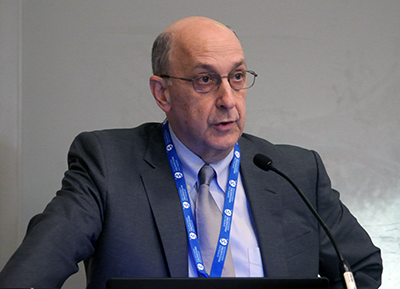Experts Describe Recent Advances in Psychodynamic Psychotherapy

“One of the most prominent myths in psychiatry today is that time-limited therapies are effective against most psychiatric illness,” said Glen O. Gabbard, M.D. (pictured above), at a symposium today titled “Advances in Long-Term Psychodynamic Psychotherapy.”
Gabbard said comparative-effectiveness studies of short-term therapies are often compromised by the large number of patients who fail to respond to either of the treatments being compared. He also stressed the pervasiveness of comorbidity. “Practitioners know this—very few people have one diagnosis requiring 12 sessions of one type of treatment,” Gabbard said. “Most psychiatric illness is relapsing, recurring, and chronic, and you don’t just get a burst of treatment and it goes away.”
His comment was a preface to remarks by experts discussing advances in interpretation of transference, treatment of narcissistic personality disorder (NPD), understanding and analysis of resistance, and the evolution of psychodynamic treatments for borderline personality disorder (BPD) and posttraumatic stress disorder (PTSD).
Eve Caligor, M.D., a clinical professor of psychiatry at Columbia, discussed psychodynamic treatment of NPD. She began with the presentation of five case examples of NPD, demonstrating the very large variability in patient presentation, including high-functioning patients and those who are more vulnerable and impaired in daily functioning.
Caligor especially emphasized the important contribution of the dimensional categories for diagnosis of personality disorders, including NPD, in Section 3 of DSM-5. The latter includes dimensional descriptors that more completely capture patient variability and focus on pathologies in self- and interpersonal functioning as the defining features of all personality disorders.
She also offered useful tools for assessing and treating these challenging patients. Among these are the critical need to manage countertransference. “Clinicians’ reactions to NPD tend to be powerful and typically are negative,” she said. “Anticipate the need to monitor and contain your emotional reactions to the patients.”
The largest evidence base for long-term psychotherapy has been in the area of BPD. John Gunderson, M.D., director of personality and psychosocial research at McLean Hospital, described how the development of an evidence base for several forms of structured psychotherapy for BPD—all of which require time to work—now call for offering patients a form of psychoeducation about themselves and their illness in which they learn aspects that can be further elaborated in psychotherapy.
For instance, he said the patient learns such things as “I am not alone”; “I have a recognized disorder, and that means I have some handicaps”; and “I have genes that predispose me to this illness.” Perhaps most importantly, Gunderson said, the patient learns: “I have hope and can live a stable life.”
Mardi Horowitz, M.D., distinguished professor of psychiatry at the University of California, San Francisco, noted that at the VA the mandated treatments for PTSD are cognitive-behavioral therapy and prolonged exposure therapy. Yet in discussing the value of long-term psychotherapy for PTSD, he stressed that many patients have experienced early life traumas that limit their ability to cope and be resilient after trauma later in life.
Robert Michels, M.D., provided an overview of the understanding of resistance in psychodynamic psychotherapy—one that has evolved from regarding resistance as a patient’s occasional avoidance of unconscious material waiting to be unearthed to one in which it is seen as an ongoing phenomenon that can be a valuable clinical tool for analysis.
“We now see transference and resistance as constant,” he said. “They are lenses through which to look at the process going on all the time. Resistance is not everything—but it is a way of looking at everything.”
Gabbard focused on recent studies of transference interpretation (TI) and highlighted the First Experimental Study of Transference, a randomized, controlled trial of a moderate level of TI in once-weekly psychotherapy for a duration of a year. The study compared 100 patients randomized to a group that regularly received TI or to one that did not.
The study found no difference between the two groups, with an important modifying caveat: patients with impaired object relations performed better in the group that received TI.
Gabbard said the effectiveness of transference interpretation was modified by a number of “nonspecific” factors such as empathy, warmth, acceptance, patience, trust, and feeling understood and the “therapeutic alliance.” He noted that in the NIMH Depression Collaborative Research Program, the therapeutic alliance accounted for more variance in treatment outcome than any of the treatment interventions themselves.
“Transference work is crucial when treating patients with more severe and chronic difficulties in establishing secure and fulfilling relationships as well as difficulties in establishing a favorable alliance within therapy,” Gabbard said.
|
|
|
|
|


